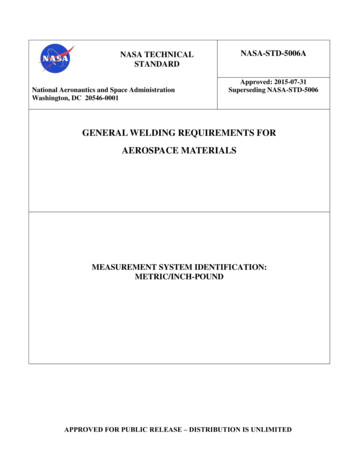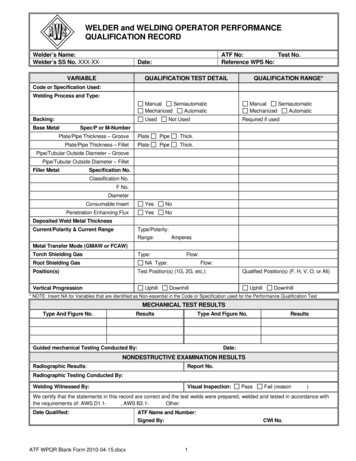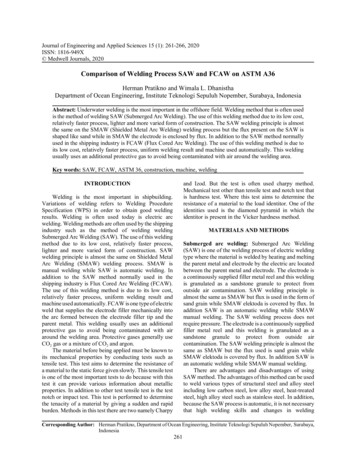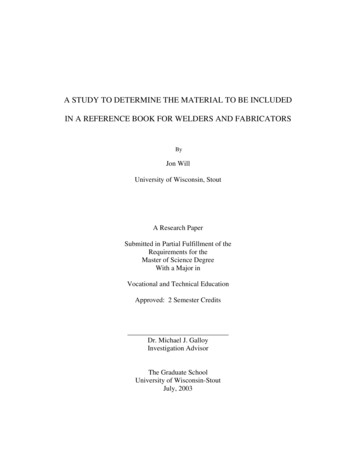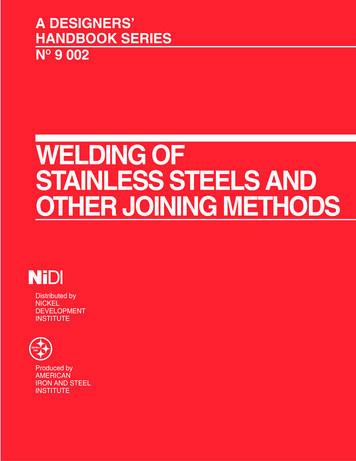
Transcription
A DESIGNERS’HANDBOOK SERIESNO 9 002WELDING OFSTAINLESS STEELS ANDOTHER JOINING METHODSDistributed byNICKELDEVELOPMENTINSTITUTEProduced byAMERICANIRON AND STEELINSTITUTE
TABLE OF CONTENTS FOR THE WELDING HANDBOOKINTRODUCTION .2STAINLESS STEEL WELDING CHARACTERISTICS .3AUSTENITIC STAINLESS STEELS .3PRESERVATION OF CORROSION RESISTANCE .5Carbide Precipitation.5Stress-Corrosion Cracking .5WELDING PREHEATING .5MARTENSITIC STAINLESS STEELS .5WELDING PREHEATING .6FERRITIC STAINLESS STEELS .7PRESERVATION OF CORROSION RESISTANCE .7WELDING PREHEATING .7PRECIPITATION HARDENING STAINLESS STEELS.7WELD ROD SELECTION .7AUSTENITIC STAINLESS STEELS .8MARTENSITIC STAINLESS STEELS .8FERRITIC STAINLESS STEELS .8PRECIPITATION HARDENING STAINLESS STEELS .8WELDING PROCESSES FOR STAINLESS STEELS .10WELDING DISSIMILAR METALS .10AUSTENITIC STAINLESS STEELS TO LOW CARBON STEELS .10PROCEDURES FOR WELDING TRANSITION JOINTS .10FERRITIC AND MARTENSITIC STAINLESS STEELS TOCARBON OR LOW-ALLOY STEELS .11USE OF CHILL BARS.11JOINT DESIGN.11PREPARATION.11POST/WELD CLEANING AND FINISHING .12WELD SPATTER .12FLUX REMOVAL .12FINISHING WELDS .12SOFT SOLDERING.13PROPER CLEANING A MUST .13SELECTION OF THE PROPER FLUX .13SELECTION OF THE PROPER SOLDER .14CLEANING AFTER SOLDERING .14BRAZING .14
The information presented in this sectionwas originally produced by the Committeeof Stainless Steel Producers, AmericanIron and Steel Institute. The originalHandbook also contained data from ASMInternational publication Joining ofStainless Steels. The Committee ofStainless Steel Producers no longer exists.The Nickel Development Institute(www.nidi.org) has reprints of thishandbook titled “Welding of StainlessSteels and Other Joining Methods” (Adesigner handbooks series No. 9 002).It should be noted that the data aretypical or average values. Materialsspecifically suggested for applicationsdescribed herein are made solely for thepurpose of illustration to enable the readerto make his own evaluation.The Nickel Development Institutereprinted it for distribution in August 1988.Material presented in the hand-book hasbeen prepared for the general informationof the reader and should not be used orrelied on for specific applications withoutfirst securing competent advice.IntroductionStainless steels are iron-base alloys containing 10.5% ormore chromium. They have been used for many industrial,architectural, chemical, and consumer applications for over ahalf century.Reference is often made to stainless steel in the singularsense as if it were one material. Actually there are well over100 stainless steel alloys. Three general classifications areused to identify stainless steels. They are: 1. MetallurgicalStructure; 2. The AlSl numbering system: namely 200, 300,and 400 Series numbers; 3. The Unified Numbering System,which was developed by American Society for TestingMaterials (ASTM) and Society of Automotive Engineers (SAE)to apply to all commercial metals and alloys.Stainless steels are engineering materials capable ofmeeting a broad range of design criteria. They exhibitexcellent corrosion resistance, strength at elevatedtemperature, toughness at cryogenic temperature, andfabrication characteristics and they are selected for a broadrange of consumer, commercial, and industrial applications.They are used for the demanding requirements of chemicalprocessing to the delicate handling of food andpharmaceuticals. They are preferred over many othermaterials because of their performance in even the mostaggressive environments, and they are fabricated by methodscommon to most manufacturers.In the fabrication of stainless steel products, components, orequipment, manufacturers employ welding as the principaljoining method. Stainless steels are welded materials, and awelded joint can provide optimum corrosion resistance,strength, and fabrication economy. However, designers shouldrecognize that any metal, including stainless steels, mayundergo certain changes during welding. It is necessary,therefore, to exercise a reasonable degree of care duringwelding to minimize or prevent any deleterious effects that mayoccur, and to preserve the same degree of corrosionresistance and strength in the weld zone that is an inherentpart of the base metal.The purpose of this booklet is to help designers andmanufacturing engineers achieve a better understanding ofthe welding characteristics of stainless steels, so they mayexercise better control over the finished products with respectto welding. In addition to welding, other ancillary joiningmethods are discussed, including soldering and brazing.The Specialty Steel Industry of North America(SSINA) and the individual companies itrepresents have made every effort to ensure thatthe information presented in this handbook istechnically correct. However, neither the SSINAnor its member companies warrants the accuracyof the information contained in this handbook orits suitability for any general and specific use,and assumes no liability or responsibility of anykind in connection with the use of this information.The reader is advised that the material containedherein should not be used or relied on for anyspecific or general applications without firstsecuring competent advice.2
Stainless Steel WeldingCharacteristicsDuring the welding of stainless steels, the temperatures ofthe base metal adjacent to the weld reach levels at whichmicrostructural transformations occur. The degree to whichthese changes occur, and their effect on the finished weldment— in terms of resistance to corrosion and mechanicalproperties — depends upon alloy content, thickness, fillermetal, joint design, weld method, and welder skill. Regardlessof the changes that take place, the principal objective inwelding stainless steels is to provide a sound joint withqualities equal to or better than those of the base metal,allowing for any metallurgical changes that take place in thebase metal adjacent to the weld and any differences in theweld filler metal.For purposes of discussion, in welding there are three zonesof principal concern: 1) The solidified weld metal, composed ofeither base metal or base metal and filler metal; 2) the heataffected zone (HAZ) in which the base metal is heated to hightemperatures but less than the melting temperature; and 3) thebase metal which is only moderately warmed or not warmed atall. The three zones are illustrated by the drawing in Figure 1.Although risking over-simplification, the following discussionwill be helpful in understanding the metallurgical characteristicsof stainless steels and how their microstructures can changeduring welding.AUSTENITIC STAINLESS STEELSAustenitic stainless steels (Table 1) containing chromiumand nickel as the principal alloying elements (in addition toiron) are identified as 300 Series (UNS designated S3xxxx).Those containing chromium, nickel, and manganese (inaddition to iron) are identified as 200 Series (UNS designatedS2xxxx).The stainless steels in the austenitic group have differentcompositions and properties but many common characteristics.They can be hardened by cold working, but not by heattreatment. In the annealed condition, all are nonmagnetic,although some may become slightly magnetic by cold working.At room temperature the 300 and 200 Series stainless steelsretain an austenitic microstructure.While resistance to corrosion is their principal attribute, theyare also selected for their excellent strength properties at highor extremely low temperatures. They are considered to be themost weldable of the high-alloy steels and can be welded byall fusion and resistance welding processes. Comparativelylittle trouble is experienced in making satisfactory weldedjoints if their inherent physical characteristics and mechanicalproperties are given proper consideration.In comparison with mild steel, for example, the austeniticstainless steels have several characteristics that require somerevision of welding procedures that are considered standardfor mild steel. As illustrated in Table 2, the melting point of theaustenitic grades is lower, so less heat is required to producefusion. Their electrical resistance is higher than that of mildsteel so less electrical current (lower heat settings) is requiredfor welding. These stainless steels also have a lower coefficientof thermal conductivity, which causes a tendency for heat toconcentrate in a small zone adjacent to the weld. The austeniticstainless steels also have coefficients of thermal expansionapproximately 50% greater than mild steel, which calls formore attention to the control of warpage and distortion.Table 2Comparison of Welding Characteristics of 304 Stainless Steel with Carbon Steel304304 requires less heat to produce fusion, which means faster304 results in the generation of more heat for the304.304 conducts heat much more slowly than carbon steel thus304 at 212 F has a304 expands and contracts at a faster rate than carbon steel,3
An important part of successful welding of the austeniticgrades, therefore, requires proper selection of alloy (for boththe base metal and filler rod), and correct welding procedures.For the stainless steels more complex in composition, heavierin sections or the end-use conditions more demanding (whichnarrows the choice of a base metal), a greater knowledge ofstainless steel metallurgy is desirable.Two important objectives in making weld joints in austeniticstainless steels are: (1) preservation of corrosion resistance,and (2) prevention or cracking.4
PRESERVATION OF CORROSION RESISTANCEThe principal criteria for selecting a stainless steel usually isresistance to corrosion, and while most consideration is givento the corrosion resistance of the base metal, additionalconsideration should be given to the weld metal and to thebase metal immediately adjacent to the weld zone. Weldingnaturally produces a temperature gradient in the metal beingwelded, ranging from the melting temperature of the fusedweld metal to ambient temperature at some distance from theweld. The following discussion will be devoted to preservingcorrosion resistance in the base metal heat affected zone.Carbide Precipitation — A characteristic of an annealedaustenitic stainless steels such as 304, is its susceptibility to animportant microstructural change if it is exposed totemperatures within an approximate range of 800-1650F.Within this range, chromium and carbon form chromiumcarbides, and these precipitate out of the solid solution at theboundaries between the grains. The rapidity of carbidedevelopment depends on a number of factors. The actualmetal temperature between the range of 800-1650F is onefactor. Chromium carbides form most rapidly at about 1200F,and the formation falls off to nil at the upper and lower limits.Another factor is the amount of carbon originally present inthe material — the higher the carbon content the morepronounced the action. Time at temperature is a third factor.The effect of carbide precipitation on corrosion resistance isto reduce the chromium available to provide corrosionresistance. Because low-carbon content reduces the extent towhich carbide precipitation occurs, the low-carbon austeniticgrades may be preferred for weldments to be used in highlycorrosive service. 304 with a maximum carbon content of0.08% is widely used. Also available are low-carbon 304L,316L, and 317L with 0.03% carbon.321 and 347 contain titanium and columbium-tantalum,respectively, alloying elements which have a greater affinity forcarbon than does chromium, thus reducing the possibility ofchromium carbide precipitation. These stabilized types areintended for long-time service at elevated temperatures in acorrosive environment or when the low-carbon grades arenot adequate.Table 35The removal of precipitated carbides from 304 in order torestore maximum corrosion resistance can be accomplishedby annealing (at 1800 to 2150F) (above the sensitizing range)followed by rapid cooling. Stress relieving a weldment at 15001700F will not restore corrosion resistance, and, in fact, mayfoster carbide precipitation in stainless steels that do not havea low-carbon content or are not stabilized.Stress-Corrosion Cracking — The chance of stresscorrosion cracking is another reason for post-weld heattreatment. In the as-welded condition, areas close to the weldcontain residual stresses approaching the yield point of thematerial. It is difficult to predict when an environment willproduce stress-corrosion cracking and to decide how muchreduction must be made in the magnitude of residual stress toavoid its occurrence. To ensure against this stress-corrosioncracking in welded austenitic stainless steels is to anneal thetypes which contain regular carbon content, and to stressrelieve the stabilized and extra-low-carbon types.WELDING PREHEATINGThe question often arises whether an austenitic stainlesssteel should be preheated for welding. In general, preheatingis not helpful because no structural changes, such asmartensite formation, occur in the weld or the heat-affectedzones. In some cases, preheating could be harmful in causingincreased carbide precipitation, or greater warpage.MARTENSITIC STAINLESS STEELSMartensitic stainless steels, which are identified by 400 Seriesnumbers (UNS desiignated S4xxxx) (Table 3), contain chromiumas the principal alloying element. In the annealed conditionthese stainless steels have basically a ferritic microstructure andare magnetic. On heating beyond the critical temperature, theferrite transforms into austenite. If then rapidly cooled to belowthe critical temperature, the austenite transforms into martensite.In many respects, the martensitic stainless steels are similar tothe quenched and tempered carbon or alloy steels whosemechanical properties can be varied through heat treatment.Whether or not the transformations take place depends uponalloy content, especially the chromium and carbon contents.Other alloying additions may also affect transformation.
As a group, the martensitic stainless steels (hardenable byheat treatment) have certain characteristics in common whichinfluence their behavior when subjected to the temperaturesencountered in welding. These characteristics are as follows:1) Their melting points are approximately 2700F, whichcompares with 2800F for mild steel. This means that theyrequire less heat for their melting or that they melt fasterthan mild steel for the same rate of heat input.2) Their coefficients of expansion and contraction are aboutthe same as or slightly less than the corresponding valuefor carbon steel. This is in contrast to the chromium-nickelgrades whose coefficients are about 45-50% higher thanthat of mild steel.3) The heat conductivity ratings are less than half that of mildsteel depending upon temperature. In this respect, theyare similar to the chromium-nickel grades.4) Their resistance to the flow of electrical current is higherthan that of mild steel. For that reason, less amperage isrequired for their welding.In the soft annealed condition, a martensitic stainless steelsuch as 410 (the general-purpose grade) exhibits maximumductility. On heating to temperatures above about 1500F, themetallurgical structure begins to change to austenite; atapproximately 1850F the structure is completely austenititic.Cooling from these temperatures results in the transformationof austenite to martensite, a hard, strong, nonductile structure.Rapid cooling from 1850F results in maximum martensitecontent. Cooling from temperatures between 1500-1850Fresults in less martensite. These characteristic reactions toheating and cooling determine the welding behavior of themartensitic stainless steels.Martensitic stainless steels can be welded in any one ofseveral conditions: annealed, semihardened, hardened, stressrelieved, or tempered. Regardless of prior condition, weldingwill produce a hardened martensitic zone adjacent to the weld(where the temperature reaches 1500-1850F). The hardness ofthe zone will be dependent primarily upon the carbon contentand can be controlled to a degree by the welding procedure. Itshould be recognized that the sharp temperature gradients,which are accentuated by the low rate of heat conductivity,cause intense stresses to be developed due both to thermalexpansion and to volumetric changes caused by the changesin the crystal structure. Their severity may be sufficient toproduce fractures.WELDING PREHEATINGPreheating and interpass temperature control are thebest means of avoiding cracking in the welding of martensiticstainless steels. The preheating temperatures employed areusually in the order of 400 to 600F. Carbon content is themost important factor in establishing whether preheating willbe necessary.The following guide can be useful to coordinate weldingprocedures with carbon content and to accommodate thewelding characteristics of the martensitic grades:Below 0.10%C — Generally no preheating or heat treatingafter welding required.0.10 to 0.20%C — Preheat to 500F, weld, and cool slowly.0.20 to 0.50%C — Preheat to 500F, weld, and heat treatafter welding.Over 0.50%C — Preheat to 500F, weld with high heatinput, and heat treat after welding.Post-heating, which should always be regarded as anintegral part of a welding operation on the martensitic types,may be accomplished by either of two methods:1) Anneal at 1500F or higher followed by controlled coolingto 1100F at a rate of 50 degrees per hour and then aircooling.2) Heat to 1350-1400F and follow with the same coolingcycle as described in (1).If hardening and tempering immediately follow welding, thepost-anneal may be eliminated. Otherwise, anneal promptly afterwelding without allowing the part to cool to room temperature.Where permissible, the use of austenitic stainless steel fillermetal will help in preventing brittle welds. A ductile weld beadis deposited, but, of course, the hardening of the metal in theHAZ will not be eliminated.Table 46
FERRITIC STAINLESS STEELSFerritic stainless steels are also straight chromium alloys inthe 400 Series with a microstructure, in the annealed condition,consisting of ferrite and carbides (Table 4). They are alsomagnetic. On heating most ferritic types above a criticaltemperature, the structure becomes austenitic which oncooling may partially transform into martensite (but notsufficiently to impart high strength). Consequently, ferriticstainless steels are considered not to be hardenable by heattreatment. Also, there will be a tendency for the ferrite grains toincrease in size.These two structural features, (a) martensite formation and(b) grain growth, result in a reduction of ductility andtoughness. Also, rapid cooling from temperatures above 700Fmay cause intergranular precipitation (similar to carbideprecipitation in austenitic stainless steels) that results inreduced resistance to corrosion. Consequently, the ferriticstainless steels are not considered attractive from thestandpoint of weldability.In the last few years several new ferritic stainless steels havebeen introduced. These steels are characterized by levels ofcarbon and nitrogen substantially below those typicallyproduced in 430. In most cases these steels are stabilized byadditions of either titanium or columbium, or the combination ofthe two. These steels are ferritic at all temperatures below themelting point showing no transformations to austenite ormartensite. As is typical of ferritic grades they are susceptibleto grain growth, but at the lowered carbon levels thetoughness of these grades is significantly higher than thestandard grades.PRESERVATION OF CORROSION RESISTANCEAlthough fabricators would much prefer to avoid post-weldheat treatment, this operation may be vital under somecircumstances to assure adequate corrosion resistance ormechanical properties. The customary annealing temperatureis 1450F. The time at temperature depends upon the massinvolved and may vary from only a few minutes for thin-gaugesheet to several hours for heavy plate.Cooling ferritic stainless steels from the annealing temperature can be done by air or water quenching. Often the partsare allowed to furnace cool to about 1100F, followed by rapidcooling. Slow cooling through a temperature range of 1050Fdown to 750F should be avoided since it induces roomtemperature brittleness. Heavy sections usually require at least aspray quench to bring them through this range of embrittlement.Also, modifications to the steel in the form of titanium orcolumbium additions help to reduce the amount ofintergranular precipitation.Table 57WELDING PREHEATINGAlthough little danger exists from excessive hardening in theHAZ during welding of ferritic stainless steels, there is aconsideration to use preheating. Heavier sections (about 1/4inch thick and heavier) are in greater danger of crackingduring welding. However, the design of the weldment, therestraint afforded by clamping or jigging, the type of joint, theambient temperature, the weld process to be used, andsequence of welding may have almost as much influenceas the material thickness. In actual practice, a preheattemperature range of 300-450F is used for heavier sections.This point should be explored in the prudent development ofany welding procedure.For the low carbon or stabilized ferritic grades, the use ofpreheat is usually undesirable for lighter sections, less than1/4 inch thick.PRECIPITATION HARDENINGSTAINLESS STEELSIn general, the precipitation hardening stainless steels(Table 5) can be readily welded and good mechanicalproperties can be developed in weldments. However,differences in welding properties can be expected. Thosegrades containing only additions of copper or molybdenumproduce a molten pool similar to the austenitic stainless steels,while those grades containing aluminum or unusually hightitanium content may appear noticeably different and possiblywill require a greater degree of protection from the atmosphereduring welding.Changes in structure can occur in the precipitationhardening grades when they are subjected to the localizedheat of welding. It will be important to note the condition of thebase metal prior to welding; that is, whether it is annealed,solution treated, or hardened. The heat of welding willinvariably produce a solution treated or annealed base metalzone, and the post-weld heat treatments required to hardenthis zone may involve either single or double treatments.Because of the many combinations of welding and heattreatment that can be used with the precipitation hardeningstainless steels, more-detailed information should be obtainedfrom producers.WELD ROD SELECTIONProper weld or filler rod selection is important to achieve aweld metal with the desired corrosion-resistant and strengthcharacteristics. A well designed product, for example, can failin the weld zone if the weld rod selected results in the weldzone having a lower alloy content than that of the parent metal.
The characteristics of the weld metal are primarily dependenton the alloy content of the filler rod and to a lesser extent onthe degree to which the molten weld metal is protected fromthe environment. This protection is provided by the shieldinggases used in certain welding processes or by the action ofchemical fluxes applied to welding rods.The first criteria for weld rod selection is alloy content, andTable 6 lists the filler metals suggested for stainless steels. Thefollowing discussion will further help in the understanding ofwhat filler material to use.AUSTENITIC STAINLESS STEELSThe long list of stainless steel filler metals frequently causesconcern as to how to select the filler metal appropriate for agiven application. The general rule most often followed is touse the alloy most similar to the base metal being welded. Thegreater amount of chromium and nickel in certain alloys, 308for example, is useful for welding 302 and 304 base metalsand hence is standard for all the lower chromium-nickel basemetals. While the same principle applies to 316, in that theminimum chromium is higher in the weld metal than the basemetal, the designation of the filler metal is the same.Certain standards of weld metal invariably have a fullyaustenitic structure, for example, 310, 310Cb, 310Mo, and330. In these, the ratio of ferrite-formers to austenite-formerscannot be raised high enough within permissible limits toproduce any free ferrite in the austenite. Consequently, theseweld metals must be used carefully in highly restrained jointsand on base metals containing additions of alloying elementslike phosphorus, sulfur, selenium or silicon — such as basemetal 302B, 303, and 314.In selecting welding materials, there is a misconception thatthe higher the AISI number, the higher the alloy content. This isnot always true, as in the case of 347, which is a stabilized gradefor preventing carbide precipitation in high-temperature
undergo certain changes during welding. It is necessary, therefore, to exercise a reasonable degree of care during welding to minimize or prevent any deleterious effects that may occur, and to preserve the same degree of corrosion resistance and strength in the weld zone that is an inherent part of the base metal.




